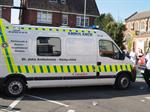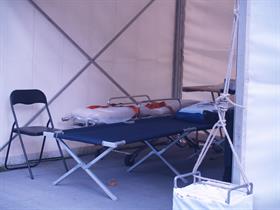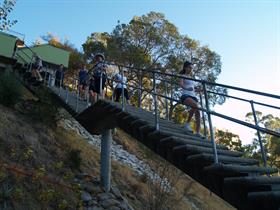 Learn to manage Fitness Risks.
Learn to manage Fitness Risks.
- Manage Risk in a gym, health club or coaching situation
- Expand your skills in sport and fitness, and enhance your career opportunities (personal training course)
- Look after your, and your clients' safety
Fitness and exercise improves your health and wellbeing, however it is important to consider the associated risks, especially if you are a fitness leader.
As a result of the wide variety of activities that may be considered as being a fitness activity it is very difficult to provide detailed lists of safety precautions for each one. There are some general rules that should be considered for all activities, including:
-
Use the correct equipment, and ensure it is in good condition.
-
Avoid unnecessarily dangerous situations such as busy roads, poor weather, poor visibility.
- Don't overdo any activity.
- Be aware of any health conditions that participants may have, and the relevant medical clearances that should be obtained.
-
Participants should be aware of their own personal limitations and exercise at a pace that is comfortable and appropriate to their needs.
- Always be prepared for first aid.

Lesson Structure
There are 9 lessons in this course:
- Understanding Human Wellness
- Advising on Human Wellness
- Fitness Tests
- Interpreting Fitness Tests
- Understanding Back Problems
- Recognising and Addressing Back Problems
- Preventative Back Care
- Understanding Weight Control
- Weight Control Methods
Each lesson culminates in an assignment which is submitted to the school, marked by the school's tutors and returned to you with any relevant suggestions, comments, and if necessary, extra reading.
Aims
- Develop skills which will enable you to advise clients on basic health issues, and promote a common sense approach to fitness and well being.
- Develop a foundation which enables the development of skills to carry out basic tests on clients.
- Be able to recognise back problems and postural defects, and subsequently assist in prescribing safe exercises; adhering to occupational safety measures.
- Develop skills and techniques to assess client needs then assist in prescribing programs to help clients control their body mass.
What You Will Do
- Describe the health status of the population living in your country, using current statistics and information.
- Describe health habits that contribute to well being and longevity.
- Explain the limitations of the person you interviewed and how their exercise routine may be altered/modified.
- Explain the implications of drugs (prescribed and non-prescription drugs) to personal health and wellbeing and fitness.
- Describe the warning signs of heart disease.
- Outline actions for each warning sign to avoid heart problems.
- Design a beginners fitness program for a person predisposed to CHR (Coronary Heart Risk).
- List the medical and alternative medicine practitioners involved in the health field and describe their relationship to health service.
- Explain how you conducted the fitness testing with respect to taking pulse at rest and during exercise; using an HR monitor such as a polar; using a sphygmomanometer
- Describe how the fitness test results you obtained from a set task can be used.
- Set a safe program for a client according to their desired outcome and ability level, using information from the screening and fitness evaluation based on a set task.
- Identify ten (10) different health problems that may restrict exercise performance, excluding back related problems.
- Draw a simple sketch of the spine, identifying structures and segments, including each of the spinal curvatures.
- List any lifestyle factors you can think of that contribute to back pain.
- Explain the purpose of a potentially dangerous or ineffective exercises and demonstrate safer alternatives.
- Identify the major postural and phasis muscles that contribute to maintaining correct body alignment and explain how they function.
- Produce a small booklet that illustrates and explains basic flexibility exercises that could be performed as a prevention exercise to back pain. Also add in a list of do's and don'ts for people to follow.
- Write a report on what you believe about genetics and the environment influencing peoples weight gain and loss.
- Write a report about anorexia and bulimia. Try to determine the ratio of males and females that suffer from these diseases. How are they believed to develop? What are present methods of helping sufferers with these problems?
WHAT IS IN EACH LESSON?
The eight lessons contain material as follows:
1. Understanding Human Wellness
- Introduction
- Self esteem
-
Motivation for learning
- How to motivate students or clients
- Reinforcement
- Understanding Stress
- Stress and the immune system
- Long term(chronic) problems caused by stress
- Physical fitness (anaerobic and aerobic)
- Safety related issues with exercise : incorrect exercises
- Safety in other aerobic activities
- Identifying hazards
- Safety maintenance in an aerobic exercise area
- Safety audit
2. Advising on Human Wellness
- Pre screening adults
- Medical symptoms, signs, health problems to watch for
- Communication with clients
- Client screening questionnaire
- Medical clearance
- Legal liability for fitness instructors
- What is a liability problem
- Contributory negligence
Insurance
3. Fitness Tests
- Risk prevention
- Before any fitness test
- Reasons for fitness testing
- What to test
- What to measure: weight, blood pressure, Body weight and percentage fat
- Heart rate
- Lung capacity
- Cardiovascular score
- Evaluating cardiorespiratory endurance
- Evaluating muscular strength and endurance
- Designing fitness tests
- Recommended procedure for conducting a new fitness test series
- Test conditions
- Combination of tests
4. Interpreting Fitness Tests
- Introduction
- Fatigue during fitness testing
- Atmospheric pressure affects
- Calculations
5. Understanding Back Problems
- Back terminology
- Types of spinal injuries
- Muscular injury
- Neurological injuries
6. Recognising and Addressing Back Problems
- Reducing risk
- Ergonomics
- Posture
- Standing
- Lying
- Furniture design
- Computer use
- Exercises for the back
- Workplace health and safety issues
- Indicators of back injury
7. Preventative Back Care
PBL Project with the following aims:
- To identify five common back problems and consider how these problems affect the quality of one’s life.
- To design exercise guidelines for people already suffering from back problems, from beginner to advanced level of exercise skill.
- To design exercise guidelines that will prevent back injury in healthy individuals, for beginners to advanced levels of exercise skill.
-
To design a management plan for an exercise facility
- Establish a procedure for reviewing and evaluating the program.
8. Understanding Weight Control
- Principle of weight control
- Endocrinology
- Nutritional advice
- Energy required for different activities
- The science of nutrition
- Energy production
- Factors affecting BMR
- Working with an obese client
- Working with an underweight client
9. Weight Control Methods
- Role of exercise in weight control
- A plan for losing weight
- Water
- Water retention
- Athletes and nutrition
- Weight management
PBL Project, with the following aims:
- To work with a client with a body mass problem and to determine the extent of this problem.
- Be able to plan a body fat reduction and maintenance program combining both exercise and diet.
- To consider the opposite situation, that is, where a client is underweight, and to plan a program to remedy this.
- Design a well balanced daily meal plan for yourself incorporating all necessary food groups and nutrients.

Learn to Exercise Safely
There are all sorts of issues that can affect your safety during exercise -both the way you exercise, and the environment in which you exercise.
Many exercise facilities have potential, and possibly existing, hazardous situations in the facility which should be dealt with immediately. Above all, when exercising (particularly on machines with moving parts), infants and pets should not be allowed into the exercise area. Keep long hair tied up and don’t wear lose clothing. Always know exactly how to adjust moving parts, to avoid injury to fingers.
Regular inspections of a facility can help identify such hazards. Ideally the facility should be inspected daily, prior to opening, to ensure that there are no obvious problems. More thorough inspections can be carried out at set intervals (e.g. weekly, monthly). Generally it will be the role of regularly employed staff to carry out such checks, however, casual or sessional staff should be aware of the fact that such checks are carried out, and that any hazardous situations (both existing and potential) they are aware of, are reported to the appropriate person. There should be correct storage procedures for equipment, appropriate and well communicated health and safety/hygiene rules and a regular maintenance routine established in fitness facilities. As a trainer, it is part of your job to make your clients familiar with all equipment they use, in your presence or absence, along with how to use/adjust it, maintain it if necessary and appropriate weights/resistances to use and when to progress to higher weights/resistance. It is also good to provide students with signs and symptoms that indicate they should stop their exercise or reduce intensity.
Identifying Hazards
Many exercise facilities have potential, and possibly existing, hazardous situations in the facility which should be dealt with immediately. Above all, when exercising (particularly on machines with moving parts), infants and pets should not be allowed into the exercise area.
Regular inspections of a facility can help to identify such hazards. Ideally, the facility should be inspected daily, prior to opening, so as to ensure that there are no obvious problems. More thorough inspections can be carried out at set intervals (e.g. weekly, monthly). Generally, it will be the role of regularly employed staff to carry out such checks however, casual and occasional staff should also be made aware of the fact that such checks are carried out, and that any hazardous situations (both existing and potential) they become aware of should be reported to the appropriate person.
To aid in inspections, a safety checklist can be devised to ensure that all recognised potential problem areas are regularly checked. Each item can be ticked off to show that it has been checked, and a note or comment made indicating the condition of the item, or any problems noted. Space should be provided on the checklist for the date the inspection was carried out, the name of the person carrying out the inspection, and for them to sign once they have completed the inspection. The checklist can be modified/updated as required to reflect such things as changes in operational procedures, addition of new equipment or facilities, ageing of facilities, and greater awareness of problem areas as a result of previous inspections.
Checklists will vary according to the type of facility being inspected. Ideally, an experienced occupational health and safety officer should be involved in developing the checklist through consultation with facility staff. Any procedures involved in carrying out the inspections should be included as well as methods/procedures for reporting existing or potential hazards that are identified.
When designing a safety checklist, you need to consider every aspect of the workplace (e.g. exercise room) including: physical facilities, people involved, materials and equipment, procedures, etc. The sample checklist below will give some ideas of items that could be included.
Using a checklist can help ensure:
- That the check/audit is comprehensive and that you have looked at everything which you had planned to consider.
- That the checks/audits are standardised so that the same things are looked at each time.
- That they are conducted in a logical and efficient way (i.e. the audit tasks performed can be arranged in a logical order that helps the person/s carrying out the check achieve the task more efficiently and effectively
WHY STUDY THIS COURSE BENEFIT
Anyone can read or be told about risks, but risks still get ignored and injuries still happen.
It takes more than reading an article or doing a short half day course before a person moves from knowing what is risky to always being conscious and alert about what can go wrong.
In order for risks to be managed well, you need to get to a point of where it is automatic for you to see potential problems, and undertake actions to minimise any risk of injuries occurring.
This requires a longer course where you take time to study those issues in greater dept, in a range of contexts; then revisit, review and reconsider issues a number of times. When you do that; your learning becomes more deeply embedded in long term memory and hence it becomes increasingly "automatic" for you to see a situation, evaluate risks, and move forward in a way that reduces risk.
This course can be valuable for anyone involved with advising or managing people during physical activity, including:
- Fitness Leaders
- Personal Trainers
- Sports coaches
- Gym managers
- Anyone who works with sporting facilities, equipment or service